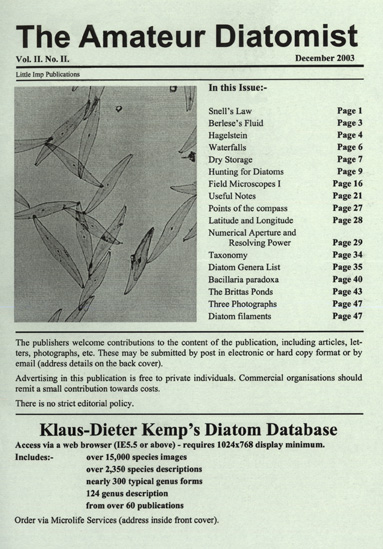The Amateur Diatomist
The Amateur Diatomist
Edited by Steve Gill, Mike Samworth, and Steve Edgar
Little Imp Publications.
The Amateur Diatomist
c/o D.S. Gill
123 The Longshoot, Nuneaton, Warwickshire CV11 6JQ
England
Format ~ 8 ¼” x 5 ¾”; illustrated; 50-54 pages

NOTE: This review was originally posted in 2005. The Amateur Diatomist is now available online.
The second year of this delightful journal has recently ended, and subscriptions are now being taken for the next four issues, which will comprise Volume III. Volume I, Number I was issued March 2002, with the statement that “The primary aim of this new publication is to further the interest in diatoms amongst the amateur naturalist. This amateur-centric approach has been much neglected, though a few hardy individuals have plugged away and contributed substantially to present day understanding of and distribution of the Diatoms.” The articles in the first issue included: What is a Diatom? Where to Find Diatoms; Mounting Techniques (1); Cleaning Diatoms – Part 1; Diatom Genera; and The Diatom Frustule.
Articles in Volume I, Number II (June 2002) included:
Mounting Techniques (Part II); The Strew; Cleaning Diatoms – Part II; Diatom Genera – Part II c-d; Species of Diatomaceae, Use of the 8-Form Test Plate, and a review of the CD: Report on the Irish Diatomaceae, by Rev. Eugene O’Meara (1875).
Volume I, Number III (December 2002) included articles on Mounting Techniques III – Dry Mounts; Famous Diatomists – Henri van Heurck; Morphology of the Genera; Cleaning Diatoms – III; Diatom Genera, Diatom Reproduction, and Dark-Ground Technique I.
Volume I, Number IV (March 2003) had articles continuing the discussion of Mounting and Cleaning diatoms, Diatom Genera, and Dark-Ground techniques. In addition, there were articles on Guano, the Value of Type Slides; and a Species List for Malham Tarn.
The issues up to this point were produced by the Editors with their own funds.
Volume II, Number I (September 2003) contained articles on Pure Diatom Cultures; Famous Diatomists – Thum; Mounting Techniques–Storax; Holiday Diatoms; a Genera List –P; and www sites of interest. There was also information provided about Klaus-Dieter Kemp’s Diatom Database.
Volume II, Number II (December 2003) had articles on Hunting for Diatoms; Field Microscopes; Useful Notes; Taxonomy; Diatom Filaments; and a Diatom Genera List.
Volume II, Number III (March 2004) contained articles on A Diatom’s Name; Refractive Index; Mounting Techniques VI; Old Papers Revisited: Diatoms of Hertford; and the Diatom Collection of the Natural History Museum.
Volume II, Number IV (November 2004), the most recent issue, contains articles on Deformations; Armenian Diatomite; Cleaning Diatoms; Flatters and Garnett; Field Microscopes; Famous Diatomists; Diatomite Insulation; and 24 Very Rare Diatomaceae. In addition, there is a List of Subscribers, and an offer of Diatom Mountants (Naphrax or Pleurax).
Professional microscopists in this and other specialties will find this charming publication useful and informative. My subscription is in, and I can’t wait to read the first number of Volume III!
UPDATE 2/18/2013
Eight issues of the two volumes of The Amateur Diatomist were reviewed above, and much later, the publication ceased due to an insufficient subscriber base to support further printed versions (after sixteen issues of the four volumes, printed between March 2002 and July 2009). However, the editors and contributors, being passionate about diatoms and their microscopical study, were not about to give up! The result is an online electronic version of the publication on The Amateur Diatomist website.
The welcoming home page of The Amateur Diatomist displays eight tabs:
Home; Vol.5.pt.I; Archive; Downloads; Letters; Exchanges; About; and Links. Immediately following the Home page is the new Volume 5 Part I, which amounts to 113 pages when printed out! The topics covered here include an Editorial; The Search for St. Peter (Hungary); Kentmere; W.A. Firth species list; Piperine; Six Degrees of Separation; Sozodont; Field Microscope VIII; pH – A Dummies Guide; The Work of Thomas Castle; Diatoms in Colour; Old Papers – Revisited; Thum Type Plate A; Gutter Snipes; and Epiphytic Diatoms. All of these individual articles are abundantly illustrated with both black-and-white and color photos.
The Archive tab not only consists of a nine-page Index to Back Issues, but, thanks to contributors, has links to scanned issues of all previous printed volumes of the publication! Thus, readers new to this publication will not have to miss a thing.
The Downloads tab provides links to a number of free downloads, including World Diatomite Locations v3.04; The Light Microscopist’s Diatom Glossary (2nd Ed.); Provenance Abbreviations; Flat Screen Lightbox; The Meakin Diatom Collection; and the most recent, An Introduction to the Microscopical Study of Diatoms – a 500+ page book available as a free download, which is reviewed separately. The book is hosted at two sites; one in Britain, and one in the United States.
The Letters tab is set up for the administrator to post received letters and emails.
The Exchange tab is set up for the exchange of material, slides, and equipment between like-minded individuals or groups. At the moment, there are three printed pages of Diatom Resource DVDs offered in exchange for fossil diatomite (cleaned or uncleaned) or good strew slides of the same. What a wonderful opportunity this is!
The About tab leads to a summary of the site content and philosophy.
The final Links tab leads to other sites of interest to diatomists, including Klaus D. Kemp – Microlife Services; Bill Krause – Savona Books; Leszek Wolnik – Diatoms Ireland; Prof. Bill Dailey – ZRAX; Leszek Wolnik & Charles Suslavage; A Cabinet of Curiosities; The Quekett Microscopical Club; The Postal Microscopical Society; and the Manchester Microscopical & Natural History Society.
This new website has got to be the greatest bargain of the year!
UPDATE 10/27/2014
Vol.6.pt.I, which amounts to 102 pages and includes an extensive coverage of John Ralfs, is now available.
Comments
add comment